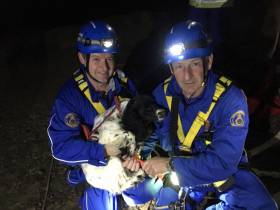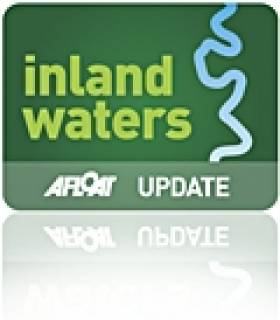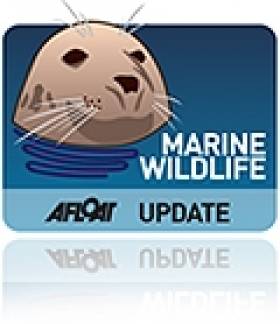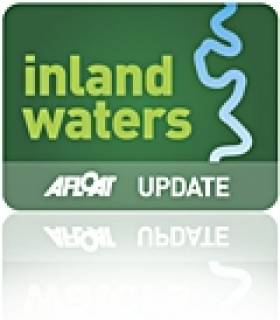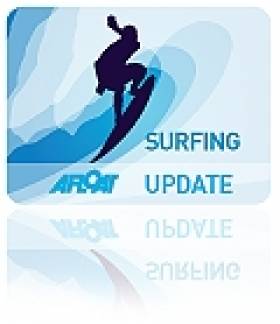Displaying items by tag: Co Antrim
#Rescue - Coastguard units from Ballycastle and Coleraine were tasked on Friday night (26 May) to the aid of a dog fell more than 30 feet off a cliff near the Giant’s Causeway in Co Antrim.
The coastguard teams used their specialist rope rescue equipment to lower a technician down the cliff to secure Bell the springer spaniel and lift her up to her grateful owners.
Belfast Coastguard reminds anyone with pets on or near the water to keep them on leads, especially close to cliffs. If an accident should happen, don't attempt a rescue yourself – always call the coastguard who are trained for the purpose.
In other news from the North Coast, the iconic Carrick-a-Rede rope bridge is closed until further notice after vandals attempted to cut it down.
TheJournal.ie has more on the incident last week, as the National Trust awaits investigation by structural engineers to determine the extent of the damage to the coastal tourism attraction.
Red Bay Lifeboat Rescues Three From Drifting Speedboat
#RNLI - Red Bay RNLI has rescued three men yesterday afternoon (Sunday 1 November) after they got into difficulty on a 4m speedboat which was drifting out to sea off the North Coast.
The volunteer lifeboat crew was alerted by Belfast Coastguard just before noon and requested to go the aid of three people on a broken down vessel which was lost somewhere off Cushendun.
One of the casualties had managed to raise the alarm with a relative using his mobile phone.
The inshore lifeboat, helmed by Kevin Allen and with crew members Stephen Conway, James McLaughlin and Owen McKinley onboard, launched within minutes and made its way to towards Cushendun.
Despite an extensive search on scene the lifeboat crew could not locate any vessel in distress in the specific search area.
The lifeboat crew widened their search and requested the assistance of the Sligo-based Irish Coast Guard helicopter Rescue 118.
After searching for two-and-a-half hours in what were described as difficult weather conditions, the lifeboat crew finally located the vessel some four miles off Garron Point at Red Bay. The boat was drifting out in blustery sea squall conditions.
The three men, who were not in immediate danger but suffering from shock, were taken onboard the lifeboat and brought safely back to Red Bay where they were made comfortable.
Speaking following the callout, Red Bay RNLI volunteer lifeboat press officer Paddy McLaughlin said: "These three men were extremely lucky this afternoon as their small vessel had broken down and was rapidly drifting out to sea.
The callout was particularly challenging for the lifeboat crew as the casualties were unsure of where they were lost and it took a considerable amount of time to find them.
"Our crew is highly trained and using their navigation skills particularly, they were able to locate the casualties, all of whom were relieved to see the lifeboat, and bring them safely back to shore this afternoon."
McLaughlin added: "We would remind anyone taking to the water to carry a means of communication and plan your trip in advance so you are familiar with the area should you get into any difficulty and need to request assistance."
Woman Rescued From Islandmagee Cliff
#Rescue - A woman is in stable condition in hospital after she was rescued from a sea cliff in Islandmagee on Tuesday (27 October) an operation that "wasn’t straightforward", as the News Letter reports.
It's believed the woman had been walking along the top coastal path when she got into difficulty late on Tuesday evening.
She was airlifted from the site by helicopter tasked from Scotland after being stabilised by paramedics.
The incident comes just weeks after emergency services rushed to the aid of an elderly man who fainted on the newly reopened Gobbins cliff walk in the same area.
The new cliff path has been hailed by the Guardian as "a reboot of a magnificent feat of engineering that originally opened in 1902", with local musical hero Michael Bradley of the Undertones writing about its heart-stopping mix of beauty and danger.
Man Faints On Newly Reopened Gobbins Cliff Path
#CoastalNotes - Emergency services rushed to the aid of an elderly man who fainted on the new cliff walk at The Gobbins in Co Antrim on Thursday (3 September).
As BelfastLive reports, the 79-year-old collapsed half-way along the "white-knuckle" coastal path that recently welcomed its 1,000th visitor since reopening last month for the first time since the 1950s.
The path was closed during the incident as the man recovered enough to walk away with the aid of council staff and local fire fighters. He was subsequently pronounced fit and healthy by paramedics at a waiting ambulance.
Mid and East Antrim Council has warned that the dizzying Gobbins path requires a reasonable level of fitness to traverse its series of rugged steps, tunnels, caves and tubular bridges that are not for the faint-hearted.
NI Officials Investigate Fish Kill in Newtownabbey
#INLAND WATERWAYS - Officials at the Northern Ireland Environment Agency (NIEA) are attempting to find the source of a pollutant that resulted in a fish kill on the Threemilewater river in recent weeks.
The Newtownabbey Times reports that more than 120 trout and salmon parr have been found dead on the short stretch of river between Mossley Mill and Doagh Road in Newtownabbey, Co Antrim.
John Webster of the Threemilewater Conservation and Angling Association speculated that the pollutant may have entered the water from any of a number of pipes that flow into the waterway near the railway line at Mossley Mill.
He described the fish kill as "an absolute diasaster", especially coming as it did at the opening of the fishing season on 1 March.
The Newtownabbey Times has more on the story HERE.
Four News Records in Irish Specimen Fish Committee's 2011 Report
#ANGLING - The Irish Specimen Fish Committee's annual report for 2011 features catch details for 587 specimen fish as well as four new records, according to The Irish Times.
The report comes ahead of the committee's annual awards event at the Red Cow Moran Hotel in Dublin on Saturday 3 March, recogising those anglers who work hard to catch and record the biggest fish of each of Ireland's species.
Those in line for awards include Terry Jackson, who caught a 2.1kh roach/rudd hybrid in the River Lagan; Dutchman Jan Vrieswijk who landed a 1.33kh blackmouth dogfish in Red Bay, Co Antrim; and Noel Lane for his 2.83kg thin-lipped mullet from Cork Harbour.
The Irish Times has more on the story HERE.
Body Found on Scottish Beach Believed to Be Missing NI Woman
The body of a woman found washed up on a beach in Scotland's Mull of Kintyre is believed to be that of Northern Irish woman Karen Coyles, who disappeared from her home in Ballycastle, Co Antrim on 11 September.
The Irish Times reports that a tourist found the body yesterday afternoon. It is believed to have been in the water for some time.
A postmortem will be carried out today on the body, the identity of which has yet to be confirmed.
A major search and rescue operation had been launched for Coyles, 47, whose car was found at McQuillan's GAA club where she is captain of the camogie team.
More Whales Spotted in Irish Waters
Killer whales and a humpback whale have been spotted off the coast of Northern Ireland in recent weeks, according to the Irish Whale and Dolphin Group (IWDG).
Irish Weather Online quotes the IWDG's Pádraig Whooley, who said three killer whales - or orcas - had been seen off Rathlin Island in Co Antrim on 10 June. Two more were later spotted between the Down coast and the Isle of Man.
Then on 14 June a humpback whale was sighted off Bangor - only the third time the species has been seen in Northern Irish waters.
"Any sighting today of a humpback whale sends out a very strong conservation message," said Whooley.
Antrim Sping Cleaners Find Riverbed Bomb
Inland Waterways Spring cleaners at Sixmilewater River in Co Antrim got the surprise of their lives last weekend when a Second World War mortar shell was discovered in the riverbed.
Volunteers for Big Spring Clean Week had already picked it up from the water, thinking it at first to be a piece of metal piping, before they realised what they really had on their hands.
The Belfast Telegraph reports that the shocking find sparked a security alert for most of the day. The nearby Dublin Road was closed while army bomb disposal experts removed the device for examination.
The bomb was described a being 20 inches long, "torpedo-shaped" and "pale green".
It joined a list of random items including a bicycle, three scooters, golf clubs and a taxi sign that were retrieved from a single 100m stretch of the river near the Antrim Forum.
Portrush Open Surfing Championships This Weekend
The 2011 Portrush Open Surfing Championships take place this weekend from 9-10 April.
Ireland's best surfers are expected to take part in the two days of competition, which will also be the decicing contest for selecting surfers to represent Ireland at the European Championships in Bundoran later this year.
Causeway Coast Surf Club chairman Gerard McAuley told the Coleraine Times: “The Portrush Open is now Ireland’s best surf contest. As surfing becomes more and more popular, we are expecting large numbers of competitors and spectators to attend."
Top internationals Cain Killcullen, Aaron Reid and Ronan Oertzen are set to clash with the likes of local prospect 'Long' John McCurry in the men's open, while Easkey Britton is setting her sights on the women's open title.
The weekend will also feature events such as art exhibitions and a packed entertainment programme for competitors and spectators alike.
For more details visit www.northcoastni.com or www.causewaycoastsurfclub.co.uk.
The Coleraine Times has more on the story HERE.


























